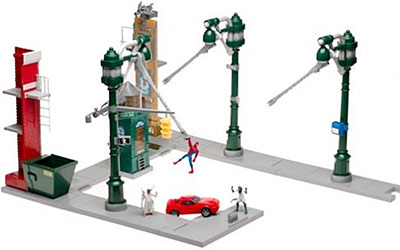Spiderman Stunt System
Interlocking magnetic pieces form various city scenarios in which the superhero swings
 This system of interlocking pieces is designed to look like the city that Spiderman lives in. The special magnetic stunt action Spiderman can be set up to independently swing from web to web and perform a variety of stunts. To further evoke the imagination the whole system can be arranged in a number of senarios. A variety of kid-powered features are also built in to actively involve them in the fun. Two three-inch magnetic stunt action Spiderman Figures and three-inch Dock Ock and Lizard are included with a pull back and go chase car.
This system of interlocking pieces is designed to look like the city that Spiderman lives in. The special magnetic stunt action Spiderman can be set up to independently swing from web to web and perform a variety of stunts. To further evoke the imagination the whole system can be arranged in a number of senarios. A variety of kid-powered features are also built in to actively involve them in the fun. Two three-inch magnetic stunt action Spiderman Figures and three-inch Dock Ock and Lizard are included with a pull back and go chase car.
The history of stunts in movies is as old as cinema itself, offering audiences a thrill that dialogue and plot could not deliver alone. In the early days of silent films, actors often performed their own stunts, with Harold Lloyd's death-defying clock tower scene in "Safety Last!" (1923) being one iconic example. As the film industry progressed, the role of the professional stuntman and stuntwoman emerged, allowing for more complex and dangerous feats. Advancements in technology and safety equipment made it possible for stunts to become increasingly elaborate, shifting from simple horseback riding and fistfights to car chases, high falls, and full-scale explosions. Movies like "Bullitt" (1968) with its legendary car chase and the James Bond series set new standards for stunt work. The evolution of special effects, wirework, and CGI has further expanded the boundaries of what is possible, but practical stunts remain a highly respected craft in filmmaking. The inclusion of stunts not only elevates the excitement level but also adds authenticity and visceral energy to a movie, making it a vital element in genres like action, adventure, and thriller.
